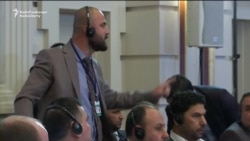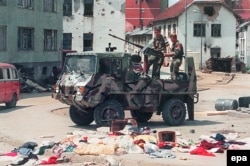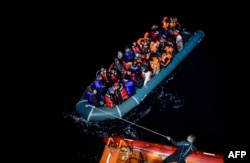If history is any indication, the creation of a series of safe zones in Syria, currently being discussed by the United States, Russia, Turkey, and the war-torn country, is likely to provide little relief for hundreds of thousands of civilians on the ground.
Moscow, Ankara, and Tehran on May 4 signed a memorandum backing a Russian proposal that calls for such zones to be created in rebel-held territory in northwestern Syria. The United States said it supported any effort to de-escalate the violence in Syria, though it had "concerns" about the agreement.
But for years, policymakers around the world have looked to safe zones as a way to protect civilians, unlock humanitarian access, and help move a conflict toward a political solution.
That sounds good in theory. But the practical results aren't very encouraging.
From Bosnia, to South Sudan, to Rwanda, to Iraq, areas set up to keep noncombatants safe in a war zone have often ended up failing to provide the protection they were intended to afford.
Perhaps nowhere was that more apparent than in Bosnia-Herzegovina, when the United Nations created six safe zones in 1993 amid the bloody breakup of Yugoslavia.
The zones came to be seen by critics as little more than prison camps for refugees, where overcrowding and a lack of military backup made those inside the areas little more than sitting ducks. All six were attacked and two, Srebrenica and Zepa, were overrun.
In July 1995, the Bosnian situation hit a low point when 400 lightly armed Dutch troops in Srebrenica under a UN mandate failed to stop the murder of some 8,000 Bosnian Muslim men and boys. Women and girls were raped. Inside a week, a safe zone had become the scene of the deadliest atrocity in Europe since World War II.
While many safe zones before and after Srebrenica have had varying results, few have been deemed outright successes and the complex situation on the ground, analysts say, makes it unlikely at best that Syria would be the exception and not the rule.
"These safe zones have a very bad history," says Louis Charbonneau, United Nations director at Human Rights Watch (HRW). "You have all sorts of risks once you concentrate people in one place like that.... They are targets."
What Is Being Proposed?
The Russian proposal urges the creation of safe zones in rebel-controlled territory in the northwestern Syrian province of Idlib, in parts of Homs Province in the center, in the south, and in the opposition enclave of Eastern Ghouta near Damascus, according to the AFP news agency, which cited a copy of the plan.
WATCH: Syrian Opposition Protests As Deal On Safe Zones Signed (natural sound)
While those safe zones would seek to stop conflict inside the area and allow refugees to return, another key aspect would be to allow for the delivery of aid to people who have suffered through years of an ongoing civil war.
The zones would be guarded and have checkpoints manned by rebels and government troops. Foreign troops could also be deployed in observer roles, according to the document, AFP said.
Details of the plan, such as who would pay the huge budget needed to maintain the zones and how they would be controlled, must still be worked out, Russian President Vladimir Putin said on May 3, after talks with Turkish President Recep Tayyip Erdogan at the Black Sea resort of Sochi.
"One of the ways in which the cease-fire can be made to last is through creating safe zones or de-escalation zones," Putin said, adding that aircraft "would not work" in the de-escalation zones "provided there is no military activity in these zones."
ALSO READ: Russia, Turkey, Iran Sign Syria Safe-Zone Deal, As Opposition Cries Foul
Earlier reports said Putin and U.S. President Donald Trump discussed the establishment of safe zones in a May 2 phone call but suggested the sides had differing views on the topic.
U.S. Secretary of State Rex Tillerson in March said the United States hoped to set up "interim zones of stability" to help refugees return as the battle continued to defeat destabilizing militant groups like Islamic State and Al-Qaeda.
Creating Safe Zones
Safe zones aren't actually an official term under international law.
But international humanitarian law (IHL) does allow for a number of zones, such as neutralized areas for noncombatants and wounded combatants, "non-defended localities," and demilitarized zones within conflict situations, located in or outside combat areas, according to Trevor Keck, deputy head of communications for the International Committee of the Red Cross delegation to the United States and Canada.
Such zones are established with agreement or recognition by all parties to a conflict. Some have also been created by UN Security Council resolutions. Safe zones are protected by IHL because they are demilitarized.
But if they are defended by military means, the presence of combatants amid or around the protected populations entails a number of risks. In Syria, for example, talks on safe zones do not foresee an agreement by all parties involved in the conflict.
Failing to sufficiently defend a safe zone can make it a deadly trap, as witnessed in Srebrenica.
"History has shown that safe zones and no-fly zones are fraught with risks. At best, these types of interventions may bring short-term protection and relief to civilians at grave risk -- which is obviously laudable," Keck says.
"At worst, declaring an area safe without clear guarantees from all parties to a conflict, or without the requisite military force, can lead to devastating humanitarian consequences."
Rules Of Engagement
Given the risks surrounding safe zones, and the fact that they are often proposed when the parties to a respective armed conflict fail to respect the basic tenets of IHL, a clear set of rules of engagement by those defending it are a must, analysts say.
Without such rules, peacekeepers guarding safe havens become little more than observers to atrocities, as was the case in Srebrenica.
Given the lack of adherence so far to the rules of war in Syria, where chemical-weapon attacks and assaults on emergency aid crews, rescue workers, and journalists have been commonplace, the need for a strong and clear mandate for forces to engage is necessary if the safe zones will have a chance at being successful, according to Lieutenant Colonel John R. Barnett and Michael Eisenstadt of the Washington Institute.
The setup of safe zones must include a "robust, balanced air-ground team" in Syria where a complex web of rebel and extremist factions are engaged on the ground and external powers are directly assisting the regime's military operations.
"The language authorizing the operation should be unequivocally clear...the mandate should not place unnecessary restrictions on the use of forces deployed to secure the safe zone," they wrote in a paper for the institute on safe zones in Syria.
"Any safe-zone operation in Syria that ignores the lessons of the past and omits these key elements would risk a greater chance of failure, increased suffering for civilians, and potential mission creep that could lead to even more widespread conflict."
Other Risks
Establishing safe zones in Syria could mark an escalation in America's military involvement in the conflict, while they could become targets for jihadist groups if they are not adequately defended.
More than six years of war in Syria has killed an estimated 400,000 people and sent millions fleeing their homes, adding to an influx of refugees into countries in the Middle East, Europe, and elsewhere.
That influx has sparked a backlash in many countries, and some human rights analysts fear the establishment of safe zones is aimed more at stopping the flow of refugees than providing sanctuary for them.
Human Rights Watch's Charbonneau says there's a real concern that the plan hasn't fully worked through such questions as how entry to and from the zone would be regulated so that it "doesn't become a concentration camp."
"We can't rule out that it is doable.... When we look at Syria, and it's not clear that the U.S. has thought through what it will really involve," he says.
"You can't help suspecting that the real motive here is not to protect people but to keep them from going into other countries and that is a problem."
















